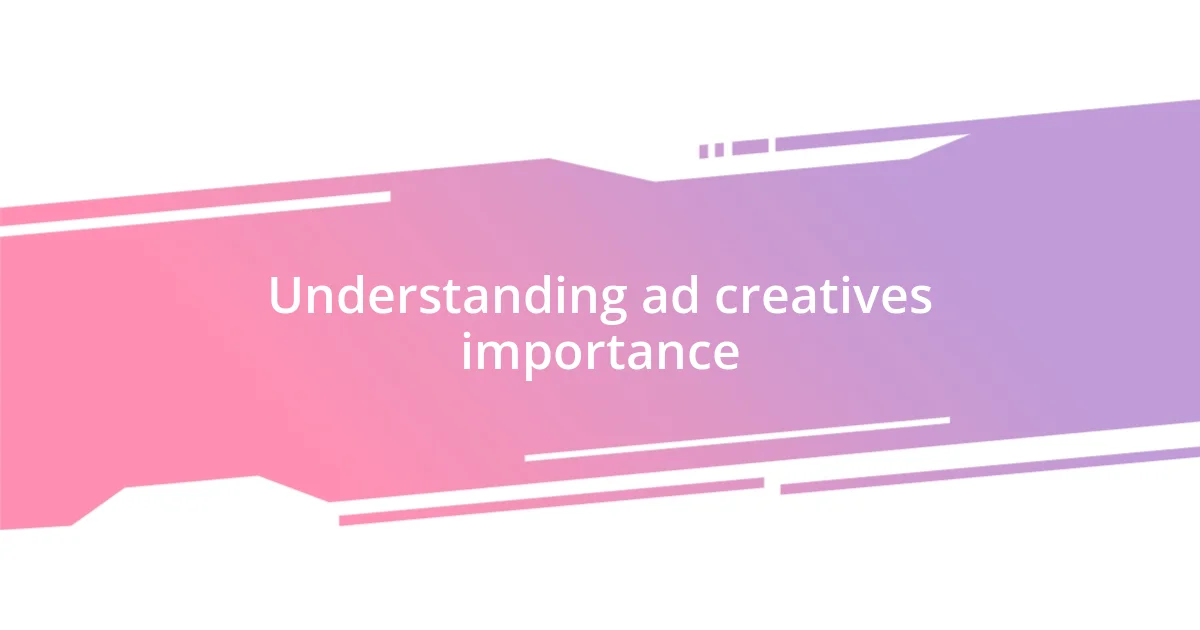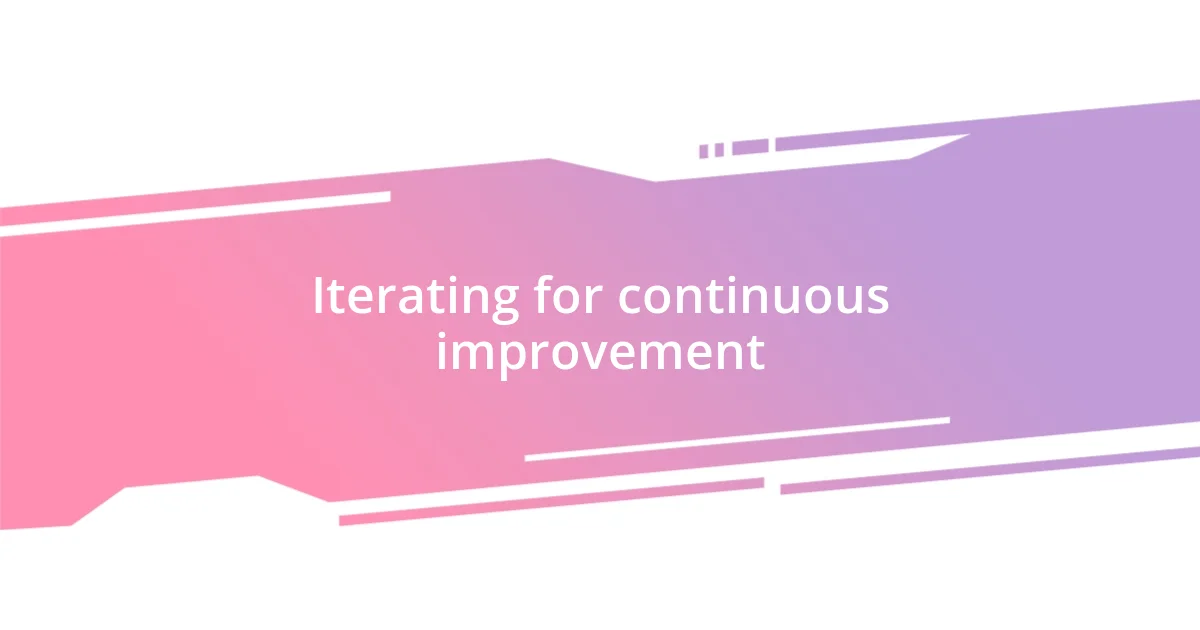Key takeaways:
- Ad creatives are essential for capturing audience attention; effective visuals and emotional messaging can significantly enhance engagement.
- Defining the target audience thoroughly—considering demographics, psychographics, and behavioral traits—ensures ad creatives resonate with viewers.
- Continuous improvement through A/B testing and feedback incorporation allows for refining ad messages and strategies to better connect with the audience.

Understanding ad creatives importance
Ad creatives are the backbone of any successful advertising campaign. I remember a time when I launched an ad that barely scraped together any clicks. The visuals were lackluster, and the messaging didn’t resonate with the audience. It was a harsh reminder of how a compelling creative can be the difference between winning their attention and getting lost in a sea of content.
Think about it: how often do you scroll past an ad that doesn’t evoke any emotion or intrigue? I know I do, and it’s concerning because it highlights the importance of creativity in capturing potential customers. When you use visuals and language that provoke curiosity or joy, you invite viewers to engage deeper.
Every ad is an opportunity—an invitation to connect and tell a story. I’ve found that the most effective ads resonate emotionally, tapping into desires and aspirations. When I crafted an ad that genuinely reflected the audience’s dreams, the engagement skyrocketed. It’s a powerful reminder that understanding the pulse of your audience can change the game entirely.

Defining your target audience
Defining your target audience is crucial for creating ad creatives that truly resonate. I’ve been in situations where I launched campaigns without clear audience definition and was left puzzled by the lack of response. When I finally took time to understand my audience’s interests, demographics, and pain points, it was like switching on a light. Suddenly, my creatives aligned perfectly with what they were looking for.
When identifying your target audience, consider these vital factors:
– Demographics: Age, gender, income level, education, and location.
– Psychographics: Interests, lifestyles, values, and motivations.
– Behavioral traits: Shopping habits, brand loyalty, and past purchasing behavior.
– Challenges or pain points: What problems is your audience trying to solve?
– Engagement preferences: Where does your audience spend their time online?
Taking the time to define these aspects not only helps in crafting effective ad creatives but also nurtures a deeper connection with your audience. It’s this connection that turns casual viewers into loyal customers.

Crafting compelling ad messages
I’ve always believed that the essence of a compelling ad message lies in its ability to speak directly to the heart of the audience. Recently, I crafted a series of ads for a product aimed at young professionals. I focused on the frustrations they face daily, and used relatable language that echoed their struggles. The response was overwhelming, showing me firsthand how tapping into shared experiences creates a striking connection.
One of my favorite techniques is to use strong verbs and emotional language. For instance, instead of saying “our product helps you,” I shifted to, “transform your routine and reclaim your time!” This subtle change made the messaging feel urgent and empowering. It’s fascinating how just a few words can elevate an ad from mundane to magnetic.
Lastly, I’ve learned that storytelling is a powerful ally in crafting ad messages. When I shared a customer’s success story in an ad, it resonated deeply with potential clients who saw themselves in that narrative. Stories create a bridge between the product and the customer’s aspirations, making the ad not just a message, but a journey they want to be part of.
| Element | Description |
|---|---|
| Emotional Resonance | Ad messages should tap into the audience’s feelings, addressing pain points or aspirations. |
| Clarity and Brevity | Effective messages are concise and straightforward, making the core idea easily digestible. |
| Call to Action | Each ad should end with a compelling call to action, guiding the audience on the next steps. |

Utilizing visual elements effectively
To truly grab attention, the right visuals can make all the difference in ad creatives. I once launched a campaign with vibrant colors and eye-catching imagery, and I was amazed at the increase in engagement. It taught me that visuals aren’t just decorations; they have the power to evoke emotions, convey messages, and draw the audience in. For instance, using images that resonate with your audience can create an instant connection. Have you ever scrolled past an ad simply because the visuals didn’t speak to you?
I’ve found that every visual element matters, from colors to typography. Take colors, for example; they can evoke emotions and influence decisions. When I used blue tones in a financial ad, people responded positively, feeling a sense of trust and reliability. Conversely, bright reds can elicit excitement or urgency. It’s all about understanding how these elements play together. Each choice you make in your visuals should reflect your brand’s personality and resonate with your audience’s emotions—after all, what feelings do you want to evoke in your viewers?
Lastly, composition is crucial. I remember an ad where I used rule-of-thirds photography, strategically placing the subject to draw the eye. The results were remarkable, as that simple technique made the ad feel professional and polished. Besides, always consider incorporating whitespace; it allows your visuals to breathe and guides the viewer’s focus to your core message. Have you embraced these techniques in your designs? If not, you might be missing out on an opportunity to elevate your advertising game.

A/B testing your ad creatives
A/B testing ad creatives is like a treasure hunt where you discover what truly resonates with your audience. I recall running two versions of an ad—one with a straightforward message and another infused with a playful tone. The playful version not only boosted engagement but also sparked conversations in the comments. This experience underscored the importance of experimentation; you never know which direction might lead to unexpected success.
When I analyzed the performance metrics, I noticed that the playful ad had a significantly lower bounce rate. It’s fascinating how small tweaks—like changing the wording or the image—can lead to such different outcomes. Have you ever been surprised by the results of a test? Embracing A/B testing has allowed me to fine-tune my approach and create ads that truly resonate with my audience.
It’s all about learning and adapting, which is what makes A/B testing so vital. Each test is an opportunity to connect deeper with your audience. The insights I gained from every round have influenced the direction of my campaigns tremendously. To me, it’s not just about finding winners; it’s about understanding my audience better and creating ads that speak to their needs and desires. So, are you ready to dive into the data and see what your audience really connects with?

Analyzing performance metrics
Performance metrics are like a compass guiding your ad creatives’ journey. When I first dove into tracking metrics, I was amazed by how much data could reveal about a campaign’s effectiveness. For instance, I noticed that a particular ad had a stellar click-through rate but a high drop-off once viewers landed on the landing page. This disconnect was a crucial insight—it highlighted the need to align the ad’s promise with the actual content.
As I analyzed metrics like engagement and conversion rates, patterns began to emerge that painted a clearer picture of my audience’s preferences. I remember one campaign where certain demographics reacted better to shorter, punchier ad copies, while others responded positively to more detailed descriptions. This variance kept me curious—could it be that different segments of my audience have unique ways of digesting information? This realization prompted me to customize my approach further, leading to improved performance across the board.
I also learned the importance of monitoring metrics over time. There was a campaign that initially performed well but followed by a notable decline in engagement after a few weeks. It made me reflect—is your audience fatigued from the same messaging? Regularly refreshing my creative strategy based on performance insights has become a game-changer. I now see metrics not just as numbers but as a map to maintaining relevance with my audience—how do you ensure your ads stay fresh and engaging?

Iterating for continuous improvement
Continuous improvement in ad creatives hinges on the willingness to iterate based on feedback and results. I vividly remember a campaign where we launched an ad that initially met lukewarm responses, leaving me puzzled. Instead of giving up, we collated user feedback, identified nuances that flopped, and created revised versions. Each iteration crafted a better connection with our audience, transforming a struggling ad into a star performer. Have you ever found gold in revisions that initially seemed underwhelming?
With those experiences in mind, I’ve come to embrace the mantra of “fail fast, learn faster.” One particular instance stands out when we ran a series of ads for a product launch. While the first few ads missed the mark, each subsequent tweak, informed by real-time data, made the message clearer and more compelling. It felt invigorating to witness engagement rise with every iteration. Isn’t it empowering to know that every misstep can lead to a breakthrough?
What I’ve learned is that improvement doesn’t happen in isolation; it thrives in a culture of collaboration and learning. Engaging with my team and brainstorming together after each set of performance metrics opened new creative doors. One idea often led to another, creating a ripple effect of innovation. So, how often do you gather insights from others to fuel your creative evolution? The synergy of collective ideas truly amplifies the effectiveness of iterative strategies.












